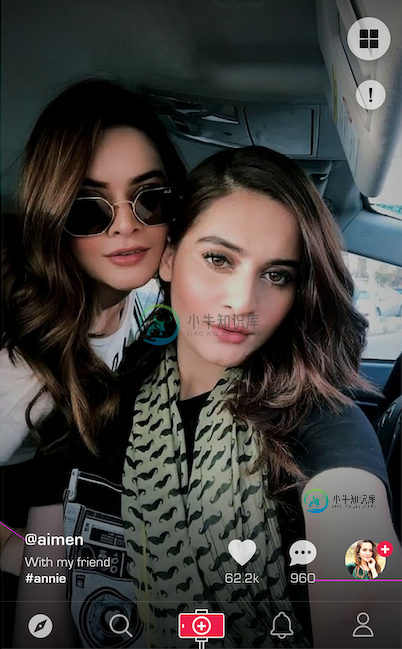颤振中的透明底部导航条
我是新手。我正在努力实现这个用户界面

我还没有找到任何使用完整的解决方案来创建颤振中的透明底部导航栏。
我试过用
BottomNavigationBarItem(
backgroundColor: Colors.transparent,
icon: e,
activeIcon: _activeIcons[_index],
title: Text(
title[_index],
style: AppStyle.tabBarItem,
),
)
但这似乎行不通。请帮忙。
共有3个答案
我就是这样做到的
return Scaffold(
body: Builder(
builder: (context) => Container(
decoration: bgAuthenticationDecoration(),
child: _HomeBodyWidget(_currentIndex),
),
),
bottomNavigationBar: BottomNavigationBar(items: <BottomNavigationBarItem>[
BottomNavigationBarItem(icon: Icon(Icons.home,),title: Container()),
BottomNavigationBarItem(icon: Icon(Icons.message),title: Container()),
BottomNavigationBarItem(icon: Icon(Icons.list),title: Container()),
BottomNavigationBarItem(icon: Icon(Icons.favorite),title: Container()),
BottomNavigationBarItem(icon: Icon(Icons.supervised_user_circle),title: Container()),
],
backgroundColor:Colors.black.withOpacity(0.1),),
extendBodyBehindAppBar: true,
extendBody: true,
);
然后你必须将画布颜色设置为透明的应用程序内主题。
canvasColor: Colors.transparent
希望这能有所帮助。
编码快乐!
我尝试使用评论中讨论的堆栈方法:
Widget build(BuildContext context) {
return MaterialApp(
home: Scaffold(
body: Stack(
children: <Widget>[
Container(
decoration: BoxDecoration(
image: DecorationImage(
image: AssetImage('assets/background.jpg'),
fit: BoxFit.cover),
),
),
Align(
alignment: Alignment.bottomCenter,
child: Theme(
data: Theme.of(context)
.copyWith(canvasColor: Colors.transparent),
child: BottomNavigationBar(
currentIndex: 0,
items: [
BottomNavigationBarItem(
icon: Icon(Icons.home), title: Text('Home')),
BottomNavigationBarItem(
icon: Icon(Icons.home), title: Text('Home')),
BottomNavigationBarItem(
icon: Icon(Icons.home), title: Text('Home'))
],
))),
],
),
),
);
}
编辑:BottomNavigationBar的内置高程为8.0,您无法更改它,这会导致奇怪的阴影效果。如果你想移除它,你可以实现你自己的底部栏,如下所示:
Align(
alignment: Alignment.bottomCenter,
child: Row(
mainAxisAlignment: MainAxisAlignment.spaceEvenly,
children: <Widget>[
IconButton(icon: Icon(Icons.home, color: Theme.of(context).accentColor,), onPressed: () {},),
IconButton(icon: Icon(Icons.home, color: Theme.of(context).accentColor,), onPressed: () {},),
IconButton(icon: Icon(Icons.home, color: Theme.of(context).accentColor,), onPressed: () {},),
],)),
没有一个给定的答案对我有用,我发现了一些非常重要的事情:你必须添加属性extendbody: true
如果为true,并且指定了BotomNavigationBar或持久的页脚按钮,则主体延伸到脚手架的底部,而不是仅延伸到底部NavigationBar或持久的页脚按钮的顶部。
当bottomNavigationBar具有非矩形形状时,此属性通常很有用,例如CircularNotchedRectangle,它会在条的上边缘添加一个浮动ActionButton大小的槽口。在这种情况下,指定extendBody:true可以确保脚手架的主体通过底部导航栏的槽口可见
连同background Color: Color(0x00ffffff),。
NB:带有0x的颜色是十六进制的ARGB值(0xAARRGGBB),所以00之前的ffffff意味着最大的透明度,可以通过将00增加到ff(十六进制为255)来增加不透明度。
完整代码示例:
import 'package:flutter/material.dart';
class NavigationBar extends StatefulWidget {
static int _selectedIndex = 0;
@override
NavigationBarState createState() => NavigationBarState();
}
class NavigationBarState extends State<NavigationBar> {
void _onItemTapped(int index) {
setState(() {
NavigationBar._selectedIndex = index;
});
}
@override
Widget build(BuildContext context) {
return BottomNavigationBar(
elevation: 0, // to get rid of the shadow
currentIndex: NavigationBar._selectedIndex,
selectedItemColor: Colors.amber[800],
onTap: _onItemTapped,
backgroundColor: Color(0x00ffffff), // transparent, you could use 0x44aaaaff to make it slightly less transparent with a blue hue.
type: BottomNavigationBarType.fixed,
unselectedItemColor: Colors.blue,
items: const <BottomNavigationBarItem>[
BottomNavigationBarItem(
icon: Icon(Icons.home),
label: 'Home',
),
BottomNavigationBarItem(
icon: Icon(Icons.grade),
label: 'Level',
),
BottomNavigationBarItem(
icon: Icon(Icons.notifications),
label: 'Notification',
),
BottomNavigationBarItem(
icon: Icon(Icons.school),
label: 'Achievements',
),
BottomNavigationBarItem(
icon: Icon(Icons.settings),
label: 'Settings',
),
]
);
}
@override
Size get preferredSize => const Size.fromHeight(kToolbarHeight);
}
那么您的MaterialApp退货地点是:
return MaterialApp(
home: Scaffold(
extendBody: true, // very important as noted
bottomNavigationBar: NavigationBar(), // here you make use of the transparent bar.
body: Container(
decoration: BoxDecoration(
image: DecorationImage(
image: ExactAssetImage("assets/background.png"), // because if you want a transparent navigation bar I assume that you have either a background image or a background color. You need to add the image you want and also authorize it in pubspec.yaml
fit: BoxFit.fill
),
),
child: Container(
// the body of your app
),
),
),
);
}
}
我希望这会有帮助。
-
在本机应用程序中,当警报或对话框打开时,状态栏和系统导航栏变为透明,但在颤振系统中,导航栏保持白色。。请帮我实现这个目标。 在本机应用程序中: (https://i.stack.imgur.com/al54d.jpg) 在颤动中: (https://i.stack.imgur.com/E3PjM.jpg)
-
我正在创建一个应用程序,我在互联网上浏览,我想知道他们是如何使这个透明的UINavigationBar像这样: 我在appdelegate中添加了以下内容: 但这只会让它看起来像: 如何使导航栏像第一个图像一样透明?
-
实现tabbar建议采用小程序原生的tabbar,通过设置page/main.js(即对应小程序中app.json)来实现,详情请看小程序文档。示例如下,仅作参考: tabBar: { color: '#999999', selectedColor: '#1AAD16', backgroundColor: '#ffffff', borderStyle: 'white', /*
-
我一直在Stack上寻找一些关于这个的指导,但是没有一个问题被问到这么深,答案也没有更新到最新的Swift版本,甚至没有更新到最新的Swift版本。 这是我所拥有的: 带有两个栏项目的导航控制器: 我的目标是:使导航根视图控制器的导航栏透明(但按钮和标题仍然可见),而不是子导航——没有奇怪的细微差别,比如之前的彩色闪光,或切断导航栏(参见gif) 我尝试过的事情: 在<代码>视图将出现(u动画:B
-
使用不包含导航器的上下文请求的导航器操作 完整代码在这里 完全错误代码 : ══╡ 用手势捕捉异常╞═══════════════════════════════════════════════════════════════════ I/颤振(3551):处理手势时抛出以下断言:I/颤振(3551):使用不包含导航器的上下文请求的导航器操作。I/flatter(3551):用于从导航器推送或弹出

